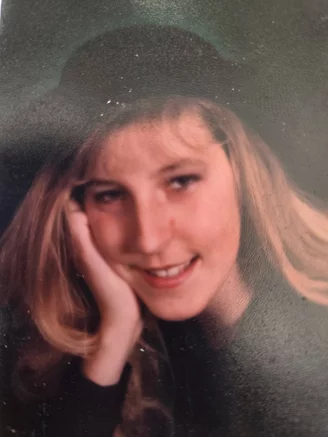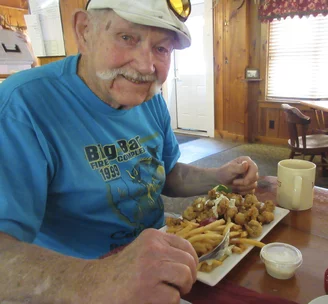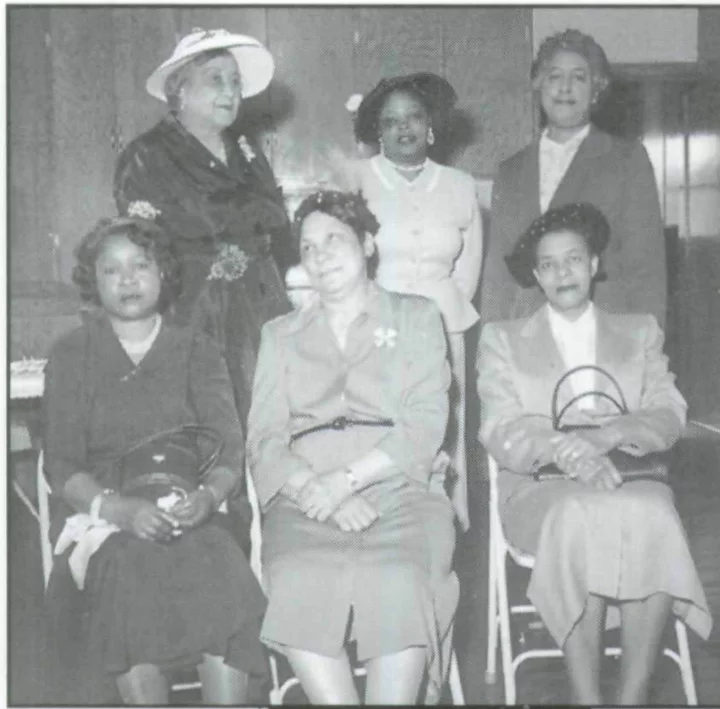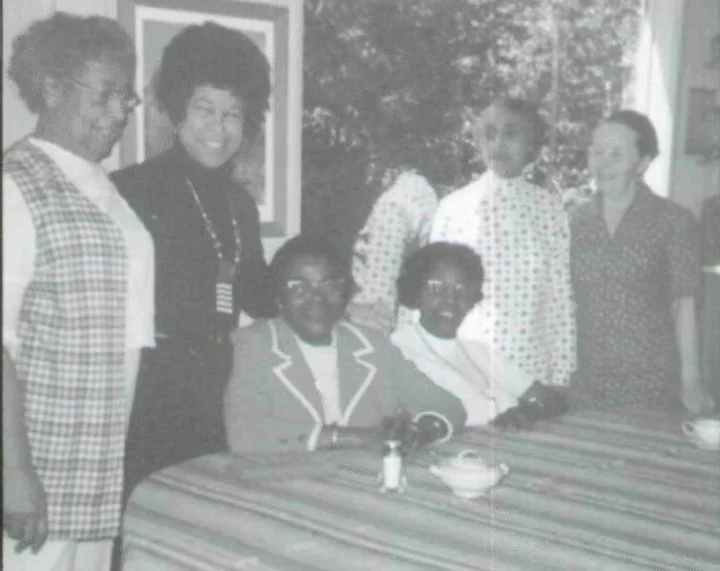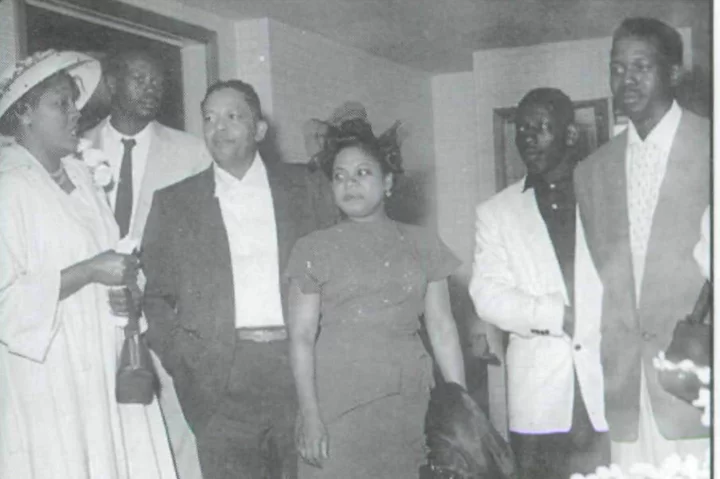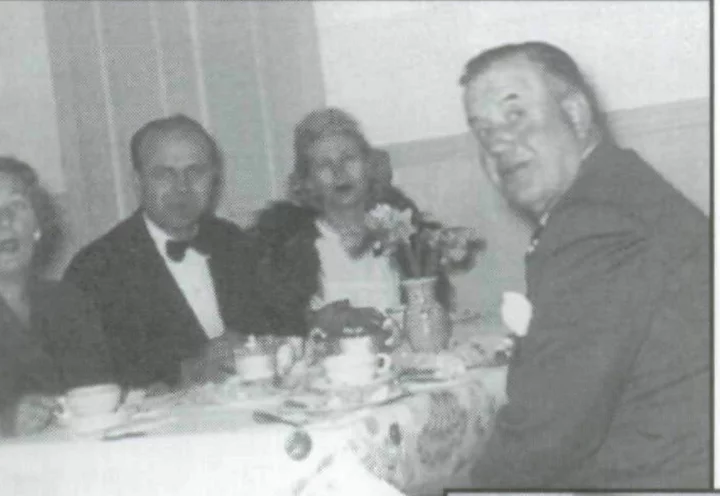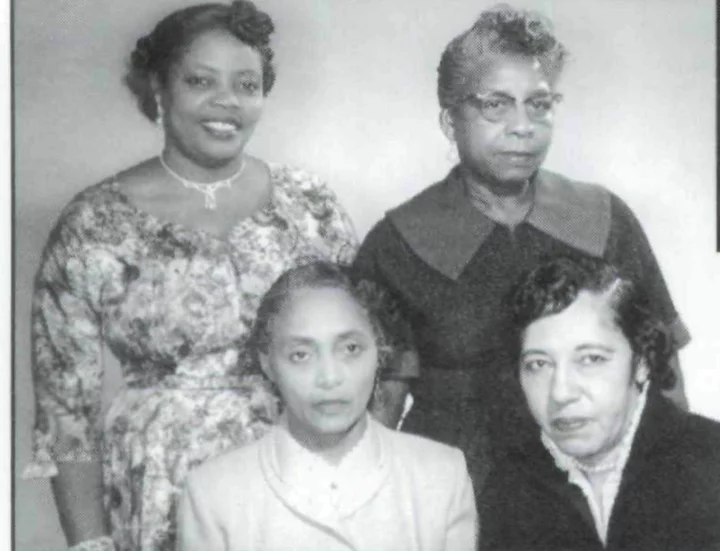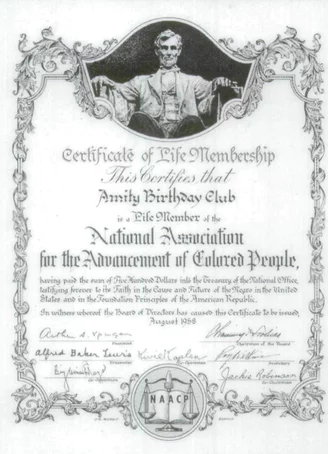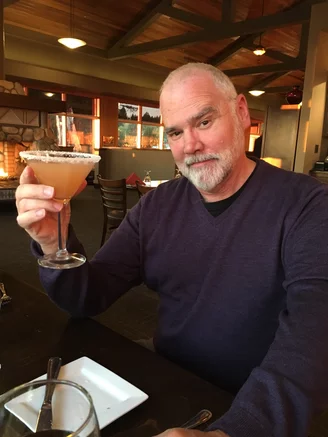OBITUARY: Elizabeth Belle Steyn, 1977-2024
LoCO Staff / Monday, June 24, 2024 @ 6:56 a.m. / Obits
Elizabeth Belle Steyn was born June 25, 1977, in Eureka, to Martinus and Wanda (Phillips) Steyn. She was 46 years old when she passed unexpectedly.
Elizabeth attended Blue Lake Elementary School and graduated from Arcata High School in 1993. She attended College of the Redwoods where she took classes in early childhood education, psychology, social work and addiction studies.
Elizabeth had no children of her own but truly loved her nieces and nephews with all her heart! Elizabeth adored all children. She was an animal lover. Her hobbies included gardening, card making for the seniors in our community at Christmas time, arts and crafts of all mediums, poetry and horseback riding.
Her one big advantage in life was when she met some people through a chat room and flew to meet them (each coming from a different state), where they gathered for a week and formed long lasting relationships. She continued her adventures traveling to 7 other states meeting and enjoying people along the way.
Family and friends in Elizabeth’s life she felt supported her throughout different times in her life and was very grateful to have had them… Justine Thomsen, Jenny Coleman, Ian, Amy Woodard, Tami Hamilton, Debbie, Randy, The HOPE Center and Dalina her best friend. Some I may be forgetting or am unaware of, but you know who you are!!
Elizabeth is preceded in death by her parents Martin and Wanda Steyn, half-sisters Kimberly Michaels, Rebecca Driver, her grandparents Gerta Snider, Lohman and Mabel Phillips.
She is survived by her faithful and loving companion Mazzie (who misses her daily), her half-sisters Justine (Cory) Thomsen, Sherri (Scott) Lesley, nieces and nephews Kelsi, Cody, Charis, Cole, Shawna, Justin. Breanne, Deanna. McKenzie, Chloe, Julianna. She is also survived by Aunt Jan Workman, her great nieces and nephews, and many cousins. Elizabeth was also God Mother to her niece Kelsi.
Elizabeth battled drug addiction and mental health issues for the last 18 years. She was overcome by the grief of losing her parents and was unable to pull herself up and climb out.
I hope you finally found your way, little sister. YOU WERE ALWAYS ENOUGH! I will love you forever — Your, Sissy.
A celebration of life will be held in memory of and in honor of Elizabeth. Please bring your favorite story and dishes to share on August 3rd, 2024, from 11 to 1 at Rohner Park, Fortuna. In lieu of flowers or other gifts, please make a donation to your favorite animal shelter in Elizabeth’s name.
###
The obituary above was submitted on behalf of Elizabeth Steyn’s loved ones. The Lost Coast Outpost runs obituaries of Humboldt County residents at no charge. See guidelines here.
BOOKED
Yesterday: 3 felonies, 4 misdemeanors, 0 infractions
JUDGED
Humboldt County Superior Court Calendar: Today
CHP REPORTS
No current incidents
ELSEWHERE
RHBB: Vehicle Hits Deer on Highway 101 Near Redcrest
RHBB: Solo Vehicle Crash Overturns Subaru on Highway 101 Near Miranda
Governor’s Office: Governor Newsom prepositions emergency resources in Southern California ahead of New Year’s Storm
OBITUARY: Mark Greenleaf, 1951-2024
LoCO Staff / Monday, June 24, 2024 @ 6:56 a.m. / Obits
Mark Greenleaf
July 27, 1951 - June 16, 2024
Mark Greenleaf lived a full life, fortunate to have shared it with a loving family and so many good friends. Born in the back of a pick-up truck, his life was marked with a sense of adventure. He spent his childhood between the excitement of the city and the wonder of nature in his rural home of Hyampom. He thrived in the woods along the family Greenleaf ranch while fishing and hunting.
As a young adult, Mark grew long hair and joined the hippy generation, traveled through Europe and rocked with up-and-coming musicians of the time. Mark enjoyed the company of friends with long discussions over the social issues of the ‘60s and ‘70s.
Mark learned the value of hard work from his father and shared his mother’s passion for old things. He had an impact on his brother Steven’s intellect as a young boy, planting seeds of interest in the arts and science. Growing up with a deaf sibling, his older brother Joe, gave Mark the empathy and awareness of the needs of others. Joe was his buddy as they grew up sharing secret conversations in sign language. This experience led him to work at the School for the Blind where over 25 years he nurtured the growth of many residential students. It was on a roller-skating field trip with his students where he met Sandy, the love of this life. They married in 1980 and spent the next 44 years together. He loved being a father and found he could extend his “joy of life” with his two daughters, Jenny and Monica.
Mark loved his second career as an advocate for the California State Employees Association (CSEA). Helping others navigate their careers and work issues was a challenging but rewarding endeavor. This role extended as a CSEA union representative and his position as President of the Central Labor Party for Humboldt and Del Norte Counties. He served where needed, such as when he pitched-in as postmaster in Hyampom while the position was vacant. He also served as a volunteer fireman in Trinity County. Throughout his life he tended to the family ranch as well, which included general maintenance, care of cows, two horses, chickens and a huge garden.
Mark had a passion for life. He liked to cook and try new recipes and share them with friends. He dabbled in poetry and journal writing. He was on the lookout for good bargains at flea markets and garage sales. He loved to read and had a keen interest in anthropology, history and tribal art. He was a traveler as well and enjoyed interacting with different cultures and people. He was an advocate for environmental justice and sustainability. He loved his dogs and played a regular game of catch with them.
Mark leaves behind his loving wife Sandra Greenleaf, his daughter Monica Filice and son-in-law Marco Filice, grandson Enzo Filice, his daughter Jenny Greenleaf, his brother Steven Greenleaf and his sister-in-law Dianne Greenleaf and his many extended families and friends whom he loved dearly. He was proceeded in death by his parents Gene and Evelyn Greenleaf and his brother Joe Greenleaf.
Mark’s spirit, characterized by generosity and warmth, will continue to live in the hearts of his family and friends.
A private memorial will be held in his memory.
###
The obituary above was submitted on behalf of Mark Greenleaf’s loved ones. The Lost Coast Outpost runs obituaries of Humboldt County residents at no charge. See guidelines here.
OBITUARY: Alton ‘Whit’ Lewis, 1937-2024
LoCO Staff / Monday, June 24, 2024 @ 6:56 a.m. / Obits
Alton “Whit”
Lewis, age 87, peacefully passed away on June 17, 2024, at Providence
St. Joseph Hospital in Eureka.
He was born on April 28, 1937, in Merced, the son of Arthur Wright Lewis and Alice Sarah Savage. They lived in Fish Camp, Mariposa County, near Yosemite, with his sister Lyla and brother Dennis. He began working in the woods at a very early age with his Dad and Grandpa, then held a number of positions in the lumber industry. He was also a heavy equipment operator and a distance truck driver. He could fix anything. He was a good cook with baked ham and the hobo breakfast two of his specialties. He loved old time country music and knew the words to many songs. He served in the US Navy from 1955-1958 aboard the USS Ajax. He had a wealth of knowledge about historic events and everyday life. His memory of family history and the birth dates of everyone he ever knew was amazing.
In 2006 he married his childhood sweetheart, Beverly Taplin and they moved to Chelsea, Vermont where Beverly had been born. He spent his time in Vermont “care-taking” the Taplin Farm as he liked to call it, and then as caregiver to Beverly as her health declined with dementia. His loss of vision due to macular degeneration was one of the hardest things he had to deal with and often said he would have rather lost his right arm than his vision. His recent health diagnosis made him want to be back home in California with his family and his old time friends. His wish was granted and he was able to say his good-byes.
He is survived by his wife, Beverly Taplin at Menig Nursing Home in Vermont, his daughter, Alice (Bill) Osborne, son, Alton Lewis, Jr. “JR”, grandchildren Abigail, William, Matthew, Heather, Andrew (Kaylie), Josh & Cameron and great-grandchildren Vivian, Christopher, Sierra, Harley, Donna Faye, Sophie and Adam Wade; Beverly’s California family, Carleen Sanderson, Chris (Melissa) Sanderson their kids Mallory & Gage, and Amber Sanderson, as well as Beverly’s Vermont family, the Alice (Taplin) Doyle family Teresa, Sandy, Jim & Andy and their families. He is also survived by cousins, nieces and nephews and many long time friends. He truly cherished their friendship and appreciated the many calls.
He was predeceased by his parents, sister Lyla (Lewis) Annibel, brother Dennis Lewis, half-brother Ralph Morris, and a son, Michael Wade Lewis who died in 1983 at age 19.
A memorial service is planned for Saturday, July 6 at 11 a.m. at Goble’s Mortuary in Fortuna. Burial will be at the Ocean View Cemetery, Sunset Memorial Park in Eureka.
The family would like to give a special heart-felt thank you to Cornerstone Care of New England for the personal escort and arranging the travel from Vermont to California.
In lieu of flowers donations may be made to the Chelsea Area Senior Center, P.O. Box 44, Chelsea, Vermont 05038 or to Mad River Community Honor Guard, P.O. Box 180, Fortuna, CA 95540.
###
The obituary above was submitted on behalf of Whit Lewis’ loved ones. The Lost Coast Outpost runs obituaries of Humboldt County residents at no charge. See guidelines here.
GROWING OLD UNGRACEFULLY: Weighing the Soul
Barry Evans / Sunday, June 23, 2024 @ 7 a.m. / Growing Old Ungracefully
My problem with Dr. Duncan MacDougall, who hailed from Haverhill, Massachusetts, isn’t so much that he was a fraud and charlatan, but that he poisoned dogs in his nutty experiments to prove that humans had souls — and that animals didn’t. In the early 1900s, MacDougall aimed to prove once and for all what philosophers from Plato on down had argued about: That humans come in two separate parts, body and soul. The soul (Plato’s anima) arrives when we’re born (or, if you’re a strict pro-lifer, at the moment of conception) and departs when we die. What happens to it after that gets kinda squirly — does it sit around in limbo, waiting for Judgment Day? Does it fly down to Hades or up to Heaven? Or find itself, unwittingly, in another body (human or otherwise)? The possibilities are endless, once you grant the existence of this thoroughly make-believe concept.
Along with many people at the time, MacDougall believed that something — call it soul — was material, and therefore it had mass. All he had to do was to weigh someone at their moment of death and see how much their weight changed. First things first, find folks about to die. Fortunately, he was working at a tuberculosis clinic, and protocols being less rigid back then, he enlisted six patients in their end stages. Four were dying from TB, one from diabetes, one unspecified. “The patient’s comfort was looked after in every way…at the end of three hours and forty minutes, he expired and suddenly coincident with death, the beam end [of the industrial scale on which the patient was lying] dropped with an audible stroke…the loss was ascertained to be three-fourths of an ounce,” he wrote in a paper published in 1907.
That was how he reported for one of his six experimental subjects. What about the other five, you ask? Here, McDougall is rather unforthcoming. He says he ignored one result because the scales “were not finely adjusted,” another died while he was still calibrating his equipment, the others — he doesn’t say. (Presumably he would have said, had the results supported his hypothesis.)
Being the fair-minded scientist he presumably saw himself as, and knowing that animals don’t have souls (only we humble humans do) he did the same experiment on 15 dogs in their death throes. Saying that he was unable to find sick or dying dogs, it’s pretty clear, as author Mary Roach puts it, “barring a local outbreak of distemper, one is forced to conjecture that the good doctor calmly poisoned fifteen healthy canines for his little exercise in biological theology.” (Stiff: The Curious Lives of Human Cadavers)
In any case, once his results (actually, result) were printed in a breathtaking story in the New York Times (March 11, 1907) “Soul has Weight, Physician Thinks,” the tale took off. Three-quarters of an ounce doesn’t really have a ring to it, but once you convert it to metric “21 grams,” you have something catchy to offer the desperate and gullible. There was the (supposedly really good, according to Rotten Tomatoes) 2004 movie 21 Grams. Many songs, including a recent release by a couple of German musicians 21 Gramm. And endless popular references.
Actual photograph of soul leaving the body. (Luigi Schiavonetti, 1808. Public domain via Wikimedia)
MacDougall’s unscientific, biased results were roundly condemned at the time. For instance, following the NYT story, another Massachusetts physician, Augustus Clarke (no relation to our local, very talented artist by that name), noted that after death, the lungs no longer cool the body, leading to sweating and consequent loss of moisture, hence weight loss. (The poor dogs, lacking sweat glands, wouldn’t have exhibited the phenomenon, even granting that MacDougall could register such a tiny change in weight.) Just 20 years ago, physician and chemical engineer Gerry Nahum unsuccessfully tried to sell Yale, Stanford and Duke on his idea that “the soul can be weighed scientifically at the point of (death) dereaction, via measuring its energy-information content, with electromagnetic sensors.” More details here. (I thought engineers were, you know, smarter.)
It’s all bullshit, of course. If you want to make a fast buck, convince folks that they won’t really be dead after they die, and that they can have another shot at life. Since they can only see an inert body when someone dies, convince them that there’s another unseen, ghostly bit that can be saved. And that if they pay you to reveal the secret of eternal life, you’ll live on. With your loved ones! Forever! (I understand that a just couple of weeks of forced confinement with their loved ones at the start of the Covid crisis had many people re-thinking that approach to the hereafter.)
Call me soulless if you will, I’m going to have to pass on that weighty topic. I’m grateful enough for just this one life.
THE ECONEWS REPORT: A Controversial Biomass Proposal’s Tie to Humboldt County
The EcoNews Report / Saturday, June 22, 2024 @ 10 a.m. / Environment
Image: Stable Diffusion.
Golden State Natural Resources, a non-profit organization, is partnering with Drax, a U.K.-based energy company, to propose two new factories to turn biomass into wood pellets and an export facility to ship the pellets to be burned for energy in South Korea and Japan. If approved, the mills would be a major expansion of biomass energy in California. Forest and climate advocates warn that biomass like this results in more carbon emissions than coal and could worsen forest conditions by driving the commodification of public lands.
Humboldt’s own Supervisor Rex Bohn sits on the board of Golden State Natural Resources through his service on Rural County Representatives of California, which provided the capital to start Golden State Natural Resources.
Rita Vaughan Frost of the Natural Resources Defense Council and Gary Graham Hughes of Biofuelwatch join the show to discuss the proposal and the risks it brings for our forests and climate.
Learn more!
- “Burning wood is not ‘renewable energy,’ so why do policymakers pretend it is?” Mongabay, June 11.
- “UK’s Drax targets California forests for two major wood pellet plants,” Mongabay, May 6.
- “Why Wood Pellets Won’t Solve California’s Wildfire Problem ,” Natural Resources Defense Council, Feb. 1.
###
HUMBOLDT HISTORY: The Amity Birthday Club, Humboldt County’s First Black Civic Association
Jessie Faulkner / Saturday, June 22, 2024 @ 7:30 a.m. / History
A support group, a religious group, a political group, a civic-minded group. The Amity Birthday Club, believed to be the first association of African Americans in Humboldt County, could rightfully claim all of these titles.
In 1952, when Margaret Neloms proposed the idea and Mary Watkins set out to make that notion a reality, it’s likely that nearly all of Eureka’s black residents knew one another. The Redwood Curtain, as many have named the cause of Humboldt County’s relative isolation, worked not only to slow the arrival of the railroad and the Redwood Highway, but to limit the region’s racial diversity as well.
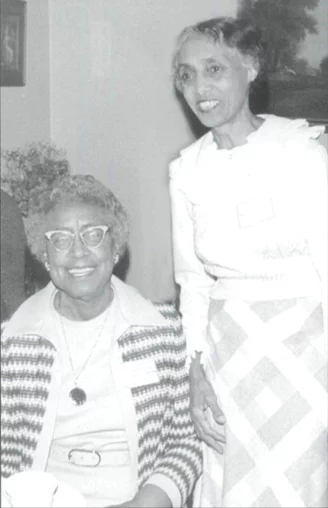
Margaret Neloms (left) and Myrtle Oneal at the February 9, 1975 Amity Birthday Club Scholarship Tea in Eureka. Photos via The Humboldt Historian.
The 1940 census shows just forty-five black people living in Eureka and fifty-two in the unincorporated areas of Humboldt County. By 1950, eighty-six African Americans called Humboldt County home while the number living in Eureka was unspecified. Humboldt County’s African American residents to this day account for less than 1 percent of the area’s residents. Unlike other areas of the country. Eureka had no racially segregated neighborhoods — with the exception of its 19th century Chinatown, which, as many know, was shamefully eliminated in 1885. The inadvertent shooting death of Eureka City Councilman David Kendall, caught in the crossfire of a Tong war, prompted city leaders to demand the exportation of all the North Coast’s Chinese residents.
The few African Americans who chose to make the North Coast their home in the first half of the 20th century had their housing choices limited only by desire and income. Yet, all was not equal. More than a decade would pass after the Amity Birthday Club’s founding before tbe Civil Rights Act of 1964 and the Voting Rights Act of 1965 became the law of the land. And, while the North Coast’s white population may have been visibly accepting, the area was not without incidents of racism.
Amity Birthday Club members, seen here at an undated gathering, included (back row) Beulah Hughes, Dorothy Taylor, Margaret Neloms, and (front row) Otelia Johnson, Ruby Desmond and Gertrude Woods.
‘Nothing But White People’
Those of color who braved a move to the predominantly white North Coast may have found themselves feeling a little hesitant about such a change. Dorothy Taylor, who joined the Amity Birthday Club just months after its organization, recalled the trepidation she felt when she and her husband moved from Louisiana to Eureka. Dorothy recalled she and her late husband, Herbert, were convinced by Herbert’s cousin, Tom Woods, that jobs were aplenty in Humboldt County and coming here would be a good idea. moved west in 1943.
“Jobs were hard to find and wages were terrible (in Louisiana),” Dorothy said.
When they arrived. Herb, some may recall as the long-time pastor of the Fields Landing church, quickly got a job working on the railroad for what Dorothy described as “very low wages.” In time and with the effect of World War II, he snagged a job at the shipyards, where he worked until its closure following the end of the war.
But Dorothy remembered the transition wasn’t an easy one.
“I had never been away from home. When we got here, there was nothing but white people,” she said.
Although she missed her home and family. Herb’s cousin and his wife were welcoming and before long Dorothy settled down and accepted her new home.
In an April 10, 1984 interview with the Times-Standard, long-time Eureka City Councilman Jim Howard, then sixty-eight, perhaps best capsulated the climate of growing up black on the North Coast. Howard had been in this area since he was six months old.
“We were the only black family here for a who good many years. Unless I was looking in the mirror, the only other blacks I saw were family,” the Georgia native joked.
In 1973, members Margaret Neloms, Marge Hill, Dorothy Taylor, Mabel Ayers, Myrtle Oneal, and Bernice Stegeman posed at a meeting.
A Club Begins
With the Amity Birthday Club’s founding in 1952, the community’s African American women had a vehicle for regular gatherings to share prayer and socialize. According to a one-page history of the club, “The name Amity was selected because it means friendship, harmony, and warm-heartedness.”
In 1992, long-time Humboldt County resident Ina Harris, one of three white women invited to join the Amity Birthday Club in the late 1960s, donated the club’s records to the Humboldt County Historical Society. Inside the box is a treasure of history and a glimpse into those who were invited to join, the meaning of their club, and its role in a climate where racial diversity was nearly nonexistent.
Membership in the club was much prized . The group’s numbers were kept at twelve or thirteen and joining was strictly an invitation-only affair. The women would gather at each other’s homes on the second Sunday of most every month for an evening of prayer, music, discussion, and, of course, celebration of one another’s birthdays. Charter members were Gertrude Woods, Beulah Hughes, Mamie Turk, Lillian Collins, Edith Howard, Zelma Gilmore, Mary E. Watkins, and Margaret Neloms. They first gathered on Eebruary 10, 1952, at the home of Margaret Neloms. Dorothy Taylor, who still lives in Eureka, said she was invited in the fall of 1952 to join by one of the club’s charter members, Mamie Turk.
Amity member Pocola Givens (in hat) and August Givens (in white jacket) gather with others in this undated photo.
Prayer, Friendship
It would be a mistake to underestimate the religious focus of the Amity Birthday Club’s monthly meetings. Sessions began with a song and ended with a Friendship Circle — friends linking hands in a circle to pray for each other’s well being until they met again. An agenda for the meetings included in the club’s collection, notes that singing of a hymn, the recitation of the Lord’s Prayer, and a devotional with responsive reading would begin the meeting. Various business matters, including the program, would follow. The Friendship Circle, another hymn, and a prayer would conclude the meeting.
“We’d open with a song and prayer and close with a song,” Dorothy recalled, — and a particular blessing: “May the Lord watch between me and thee while we are absent from one another.”
“And we needed it, too,” Ina Harris said.
Only after the meeting was adjoumed would the members hold their namesake birthday celebration. There was a birthday cake, a card signed by all the members and, at least in later years, $5 to spend as the member pleased.
An integral part of the monthly gathering was the program. Those assigned to develop a program for that month would either prompt discussion on a particular topic or person or would invite guest speakers. Ina recalled one such discussion surrounding the great contralto Marian Anderson’s difficulties with a 1939 Easter Sunday performance in Washington, D.C. The Daughters of the American Revolution had prohibited Anderson from appearing in its Constitution Hall because she was black. First lady Eleanor Roosevelt publicly protested with an immediate resignation from the DAR and arrangements were made later for Anderson to sing at the Lincoln Memorial. An estimated 35,000 people attended the concert,
Helping Others
Club members raised money for both local and distant causes.
“The first year, our project to raise money was getting people to write their names on quilt blocks,” a 1978 history of the group states. “They were embroidered by the members, when the quilt was finished it was raffled off, with the proceeds going into a scholarship fund for the Piney Woods College in Mississippi.”
Just two years later that same school — now known as Piney Woods Country Life School — would reach national attention when the school’s founder. Dr. Laurence Jones, was the featured and unsuspecting special guest on the popular 1950s television show. This is Your Life. The show’s host was so impressed with the school that he urged viewers to send in $1 each to support the black boarding secondary school. In a short time, $700,000 in donations had arrived, setting up an endowment whose earnings today cover one-half of the annual operating expenses.
Eureka Mayor Bob Madsen (second from left) and his wife, Jo, along with other guests, came to the Amity Birthday Club’s first anniversary celebration in 1953 at Runeberg Hall.
The Amity Birthday Club’s records provide no clear explanation about why Piney Woods College was chosen nor who was the lucky quilt winner. The local newspapers did take note of the Amity Birthday Club’s first anniversary. The presence of Eureka Mayor Robert Madsen and his wife at the February 1953 celebration in Runeberg Hall may have prompted that attention.
According to one account, “A huge birthday cake was the centerpiece for tables decorated with flowers and punch, chicken salad, and other delicacies were served. A five-piece band furnished music for the occasion. Madsen voiced his appreciation of the club, the only Negro organization in the city, and praised the principles upon which it operates. He also commended the members as good citizens in his Sunday night radio broadcast, ‘This is Your City’.”
Handcrafted and decorated booklets serve as mileposts for the organization’s evolution. Created for each year, the colorful records note the officers and committee chairs, the schedule of meetings for the year, and birthdays and anniversaries of members, as well as addresses and telephone numbers.
For most years, members did not meet in July and gathered in August for a picnic. The booklets of later years would note that the August picnic was a joint gathering with the local chapter of the NAACP, which got its own start in 1954.
In 1959, the Eureka Chapter of NAACP’s Fight for Freedom Campaign was honored in the NAACP’s Crisis magazine. Amity members Dorothy Taylor, Lucy Jones, Myrtle Oneal, and Edith Howard were among those honored.
Joining the NAACP
Many Amity Birthday Club members were also active in the National Association for the Advancement of Colored People. Nearly all of the husbands of early Amity Birthday Club members held active positions in the local chapter of the NAACP. and several Amity Birthday Club members had their own impact on the local chapter of the national organization. On February 18, 1956, the Humboldt Times reported that Robert Neloms would be installed as the president of the Eureka branch of the NAACP on the following Sunday. Herbert Taylor would be vice president, and E. J. Oneal, husband of Amity Birthday Club member Myrtle Oneal, would be treasurer. Board members included Myrtle Oneal and Vinnie Lenor, both Amity Birthday Club members.
Herbert Taylor would go on to head up the local chapter in 1958, according to a March 12, 1958 report in the Eureka Independent. Executive Committee members at that time included Dorothy Taylor, Jim and Edith Howard, and E. J. Oneal. Ruth Beck, a white woman, served as NAACP secretary in 1967 and 1968. Benesta L. McMillan held the same job from 1973 to 1975. while Jim Howard, husband of Amity Birthday Club charter member Edith Howard, served as president of the local chapter for five years, from 1969 to 1973.
Amity Birthday Club members took great pride in their ability to become life members of the NAACP in 1957. In the March 1957 issue of Crisis, the national magazine of the NAACP, a photo of seven of the Amity Birthday Club members is featured among those who joined for life, a feat that cost $500. The Amity Birthday Club collection at the Humboldt County Historical Society includes the group’s Ceriificate of Life Membership from the NAACP, a glimmering plaque noting the club’s life membership and signed by the national association president, chairman of the board, treasurer, secretary, and two co-chairmen.
Three years later, the local chapter of the NAACP would again make the association’s magazine.
The Eureka chapter’s Freedom Seal Committee and other offices exceeded their FFF quota in 1959. The Fight for Freedom (FFF) Campaign strove to see the fulfillment of the Emancipation Proclamation of 1863 be achieved by its 100th anniversary on January 1, 1963. Dorothy Taylor, Lucy Jones, Myrtle Oneal. and Edith Howard, all Amity Birthday Club members, were among those whose accomplishments were noted.
In 1957, Amity Birthday Club members (front row) Zelma Gilmore, Margaret Neloms, Zollie Sanders, (back row) Myrtle Oneal, Ruby Desmond, Edith Howard, and Otelia Johnson, as well as others, joined the NAACP — represented here by Robert Neloms — for life.
New Members
At least ten Amity Birthday Club members were listed on the November 1, 1968 membership list for the local NAACP chapter. Integration of the Amity Birthday Club came not long after the Reverend Martin Luther King Jr.’s message of the need for unity and peace among all God’s children — black or white. Ina Harris, Ruth Beck, and Bemice Stegeman. all white, were invited to join the Amity Birthday Club in 1968, and each maintained their membership for many years.
“Ruth and Bemice and I had been active in NAACP,” Ina said. “We were just thrilled to be invited. It was a very high social privilege.”
Of the three women invited to join in 1968. Ina Harris and Ruth Beck remain in Eureka. Ruth, who resides at SunBridge Care Center, may be more familiar to some long-time Humboldt County residents as the miracle angel of the North Coast children with polio.
During a recent encounter, Ina asked Dorothy Taylor whether inviting the white women in had changed the club. “I don’t think it made any difference,” Dorothy said. “It added strength to the club. We enjoyed having y’all, too.”
“I remember how scared I was at that first meeting,” Ina recalled. She said she remembered thinking why would they want me to join? But. it was an invitation she was quick to accept. And that created memories and friendships that have lasted through the decades.The pattern of inviting women to join the Amity Birthday Club appeared to have been a means to control the size of the group rather than a tool of exclusivity.
“Aside from Benesta (McMillan), none of the rest of us were very high falootin’,” Ina said. Ina fondly remembers Benesta, who joined the Amity Birthday Club not long after being transferred to the area in 1972. A clipping from September of that year reports that Benesta was the new operations supervisor of the Social Security district office in Eureka.
Myrtle Oneal, Zollie Sanders, Clara Nichols, Queen Washington. Alice Crosby, Marge Palms, Otelia Collins, Pearl Davis, Marge Hill, Marjorie Robinson. Zelma Gilmore, Clara Nichols. Vinnie Lenor, Mabel Ayers, Lillian Collins, and Erma Anderson are the other members whose names frequent the club’s records.
Money for Scholarships
Each December, club members would gather with their guests for the annual dinner held in a local restaurant. Members’ husbands were often, but not always, the privileged guests. In the club’s later years much energy was directed to raising monies for college scholarships. For a few years, the funds — raised through painstaking effort — were given to Humboldt State University students. Later, the scholarships were redirected to College of the Redwoods. The criterion was not strictly academics, but designed for those who “were struggling to get an education.” Some recipients were the first in their families to get a college education, others were single parents attempting to better their situation through education. All were, no doubt, grateful for the financial boost. The club’s preference was, according to a newspaper account, “a minority person or lower income Caucasian whose gradepoints are average and is struggling to acquire an education.”
Donations, bake sales, rummage sales, and food basket sales all helped bolster the club’s scholarship fund. While the effort to raise money for Amity Birthday Club scholarships was extremely serious, some of the means chosen provided a little diversion for the members. Twice a year. White Elephant auctions promised surprises and money for the effort. Ina recalls members would find something they had had around the house for quite some time, would put it in a box, wrap it up, and bring it to the meeting. Other members would bid for the mysterious contents. Usually, Ina said, it was “things you would never throw out, but didn’t know what to do with.”
The objects occasionally would do double-duty in the fund-raising world — an item purchased at one meeting might show up at the next auction, re-wrapped and again generating bids.
In February 1975. club members decided to begin holding annual Scholarship Teas — gatherings that prompted coverage in the Times-Standard and are remembered fondly by surviving members. Many of the teas were held at the YWCA — now owned by College of the Redwoods and known as the Ricks House — on the northwest corner of Eighth and H streets in Eureka. These gatherings not only honored students who were receiving the club’s scholarships, but provided an opportunity to raise money for future scholarships. Photos of those events, some of which ended up in the Times-Standard, showed members handing the scholarships to chosen students. The ladies would plan months in advance to properly honor those chosen for scholarships. “Everyone pitched in and helped,” Ina said. “Everyone worked so hard to make it a success.”
Dressed in their finest outfits, members would gather before tables laden with baked goods and silver tea services. “I have nothing but good memories of that,” Ina said.
What Remains
Good memories are nearly all that’s left of the Amity Birthday Club. In the early 1980s, several members moved away and those remaining opted not to keep up the gatherings. The emotional connections, however, still remain. Several former members gathered recently at Ocean View Cemetery in Eureka with the passing of an early Amity Birthday Club member, Myrtle Oneal. Friends and former club members joyfully greeted one another and fondly remembered Myrtle’s many kindnesses and her role as the first African American to serve on the Humboldt County Grand Jury.
###
The story above was originally printed in the Summer 2000 issue of the Humboldt Historian, a journal of the Humboldt County Historical Society. It is reprinted here with permission. The Humboldt County Historical Society is a nonprofit organization devoted to archiving, preserving and sharing Humboldt County’s rich history. You can become a member and receive a year’s worth of new issues of The Humboldt Historian at this link.
OBITUARY: Thomas Patrick Roscoe, 1957-2024
LoCO Staff / Saturday, June 22, 2024 @ 6:56 a.m. / Obits
Thomas
Patrick Roscoe (Tom), the youngest of three boys, was born on October
3, 1957 to Charles (Jim) and Mary Patricia (Trish) Roscoe in Eureka.
He passed away peacefully, his brothers and sisters-in-law
by his side, on June 13, 2024 in Eureka, due to complications from a
heart condition. Tom was the quintessential artist who wove
creativity into every aspect of his life, from his beautiful theatre
sets, gardens, wonderful edible delights, to his legendary pies. His
quick wit and clever turn of phrase were unmatched.
Tom spent his entire life in Eureka and discovered his passion for artistic creation through theatre while attending Eureka Senior High School. It was during these years Tom met his best friend, Ray Gutierrez, whose love and support he treasured throughout his life. They pulled many all-nighters over the years painting and finishing sets, laughing and getting punch drunk from lack of sleep.
Tom pursued his craft while attending Humboldt State University, fine tuning his art in set design, stage construction, masks and prosthetics for plays. Tom went on to become the resident set designer for the Ferndale Repertory Theatre. Some of the fan favorites, and most beautiful, were his sets for the fairy tale plays put on every year at FRT. Many who had attended the Sleeping Beauty/Briar Rose play still remember his stunning artistic work on that set. During this time of his life, Tom met his partner Dennis Macy and they enjoyed many wonderful years together before Dennis passed.
Years later Tom became a founding member of Redwood Curtain Theatre along with a second love, Clint Rebik. Along with other members, casts and crew, they went on to produce some of the best theatre on the North Coast. The absolute joy of Tom’s life were the years he spent with the shining light that was Clint. Tom got a kick out of Clint being the wedding officiant of two of Tom’s nieces and one nephew. He was devastated by Clint’s sudden illness and death in 2021.
Tom was preceded in death by his father, Charles (Jim) Roscoe and his mother, Mary Patricia (Trish) Roscoe along with his first life partner Dennis Macy.
He is survived by his loving family: brothers James (Kimberley) Roscoe of Bayside and Robert (Debbie) Roscoe of Davis; His nephews Daniel (Anais) Roscoe, Michael (Christany) Roscoe, and Mathew Roscoe; nieces Sara (Charles) Roscoe Smith and Lauren (Michael) Roscoe Worrell, all of whom he loved very much. Great nieces and nephews are Elanora, Winnie, Stanley and Hugo Roscoe, Aurelia and Giovanna Roscoe, and Nathan and Arthur Smith, and Jensen and Kieran Worrell. His extended family include his cousins Lee (Bill) Roscoe-Bragg and family, Jack (Gwen) Roscoe and family, Cate (Lauren Wendt) Roscoe, Michael (Carla) McNamara and family, Patty (Richard) McNamara Harper and family, along with Clint Rebik’s sons Matt Jioras-Rebik and Alex Jioras-Rebik.
There will be a private gathering to honor his life at a later date.
###
The obituary above was submitted on behalf of Tom Roscoe’s loved ones. The Lost Coast Outpost runs obituaries of Humboldt County residents at no charge. See guidelines here.

